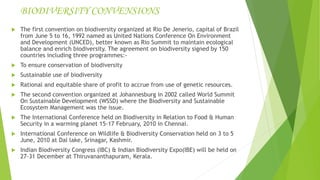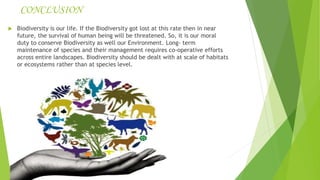Biodiversity Conservation
- 1. Biodiversity Conservation Prepared By : Rishabh Sharma M.Sc. (ES) CEEES DCRUST, Murthal
- 2. Contents: 1. Introduction 2. Concept of Biodiversity and its types 3. Distribution of Biodiversity 4. Biodiversity and balance of Nature 5. Benefits of Biodiversity 6. Threats to Biodiversity 7. Conservation of Biodiversity 8. Biodiversity of India 9. Conventions on Biodiversity 10. Conclusion 11. Referential Video Tutorial 12. Reference
- 3. So what is Biodiversity? ’üĄ Bio(living) and Diversity(variety), so when both the terms combine they give rise to the occurrence of different varieties of flora and fauna residing in a particular area and thus embarks the rise of the term Biodiversity. ’üĄ Scientifically: The variety of plant and animal life in the world or in a particular habitat, a high level of which is usually considered to be important and desirable.(http://wiki.co.in) ’üĄ The term Biodiversity was first coined by Walter G. Rosen in 1986. ’üĄ The biosphere comprises of a complex collections of innumerable organisms, known as the Biodiversity, which constitute the vital life support for survival of human race. ’üĄ Biological diversity, abbreviated as biodiversity, represent the sum total of various life forms such as unicellular fungi, protozoa, bacteria, and multi cellular organisms such as plants, fishes, and mammals at various biological levels including genus, habitats, and ecosystem .
- 4. Concept and types of Biodiversity. ’üĄ Biodiversity is the variety of life forms on earth and the essential interdependence of all living things. ’üĄ As defined in convention on Biological diversity signed at Rio De Jenerio (Brazil) in 1992 by 154 countries, the Biodiversity defined as ŌĆ£the variability among living organisms from all sources including, terrestrial, marine and other aquatic eco-systems and the ecological complexes of which the area part- this include diversity with-in species, between species and of ecosystem.ŌĆØ ’üĄ According to IUCN in 1998, ŌĆ£the variety and variability of species of their population, the variety of species of their life forms, the diversity of the complex association with species with their interaction and their ecological process which influences perform.ŌĆØ
- 5. Basic Types: ’üĄ There are three types of biodiversity 1.Diversity of Species (Species diversity)
- 7. 3. Diversity of Ecosystem
- 8. DISTRIBUTION OF BIODIVERSITY ’üĄ Flora and fauna diversity depends on:- ’üĄ Climate ’üĄ Altitude ’üĄ Soils ’üĄ Presence of other species ’üĄ Most of the biodiversity concentrated in Tropical region. ’üĄ BIODIVERSITY HOTSPOTS: ’üĄ A region with high biodiversity with most of species being Endemic. ’üĄ India have two Biodiversity Hotspots- East Himalayan Region and Western Ghats.
- 9. BENEFITS OF BIODIVERSITY Consumptive value: ’üĄ Food/Drink ’üĄ Fuel ’üĄ Medicine ’üĄ Better crop varieties Industrial Material Non-Consumptive Value: ’üĄ Recreation ’üĄ Education and Research ’üĄ Traditional value
- 10. Ecological services: 1. Balance of nature 2. Biological productivity 3. Regulation of climate 4. Degradation of waste 5. Cleaning of air and water 6. Cycling of nutrients 7. Control of potential pest and disease causing species 8. Detoxification of soil and sediments 9. Stabilization of land against erosion 10. Carbon sequestration* and global climate change 11. Maintenance of Soil fertility *The removal and storage of carbon from the atmosphere in carbon sinks (such as oceans, forests or soils) through physical or biological processes, such as photosynthesis.
- 11. THREATS TO BIODIVERSITY Natural causes: ŌĆó Narrow geographical area in terms of green cover. ŌĆó Low population of flora and fauna. ŌĆó Low breeding rate. ŌĆó Natural disasters Anthropogenic causes: ’üČ Habitat modification ’üČ Overexploitation of selected species ’üČ Invasion by exotic species ’üČ Pollution ’üČ Hunting ’üČ Global warming and climate change
- 12. RECENT ISSUES ON BIODIVERSITY ’üĄ Some 75 per cent of the genetic diversity of crop plants been lost in the past century(100 yrs.) ’üĄ Some scientists estimate that as many as 3 species per hour are going extinct and 20,000 extinctions occur each year. ’üĄ Roughly one-third of the worldŌĆÖs coral reef systems have been destroyed or highly degraded. ’üĄ About 24 per cent of mammals and 12 per cent of bird species are currently considered to be globally threatened. ’üĄ More than 50 per cent of the worldŌĆÖs wetlands have been drained, and populations of inland water and wetland species have declined by 50 per cent between 1970 and 1999.
- 13. CONSERVATION OF BIODIVERSITY ’üĄ Biodiversity inventories ’üĄ Conserving Biodiversity in protected Habitats: ŌĆó In situ conservation ŌĆó Ex situ conservation Seed Bank, Gene Bank, Pollen Bank, DNA Bank, Gene Bank zooŌĆÖs.
- 15. BIODIVERSITY CONVENSIONS ’üĄ The first convention on biodiversity organized at Rio De Jenerio, capital of Brazil from June 5 to 16, 1992 named as United Nations Conference On Environment and Development (UNCED), better known as Rio Summit to maintain ecological balance and enrich biodiversity. The agreement on biodiversity signed by 150 countries including three programmes:- ’üĄ To ensure conservation of biodiversity ’üĄ Sustainable use of biodiversity ’üĄ Rational and equitable share of profit to accrue from use of genetic resources. ’üĄ The second convention organized at Johannesburg in 2002 called World Summit On Sustainable Development (WSSD) where the Biodiversity and Sustainable Ecosystem Management was the issue. ’üĄ The International Conference held on Biodiversity in Relation to Food & Human Security in a warming planet 15-17 February, 2010 in Chennai. ’üĄ International Conference on Wildlife & Biodiversity Conservation held on 3 to 5 June, 2010 at Dal lake, Srinagar, Kashmir. ’üĄ Indian Biodiversity Congress (IBC) & Indian Biodiversity Expo(IBE) will be held on 27-31 December at Thiruvananthapuram, Kerala.
- 16. CONCLUSION ’üĄ Biodiversity is our life. If the Biodiversity got lost at this rate then in near future, the survival of human being will be threatened. So, it is our moral duty to conserve Biodiversity as well our Environment. Long- term maintenance of species and their management requires co-operative efforts across entire landscapes. Biodiversity should be dealt with at scale of habitats or ecosystems rather than at species level.
- 17. Reference video
- 18. REFERENCES: ’üĄ Roy Sovan, Environmental Science, Publishing Syndicate , 2003, Kolkata. ’üĄ Dara.S.S., Environmental chemistry and Pollution Control, S.chand & company Ltd., New Delhi. ’üĄ Schulze Ernst- Detlef, Mooney Harold, Biodiversity and Ecosystem Function, Springer- Verlag, London. ’üĄ Mohapatra Pradipta Kumar, Textbook of Environmental Biotechnology, I.K. International pub. House pvt. Ltd.,2006, New Delhi. ’üĄ Khan. T. I. Global Biodiversity and Environmental Conservation, Pointer Publishers, 2001, Jaipur. ’üĄ www.eolss.net ’üĄ www.youtube.mocomi.com ’üĄ www.ibc2010.com


















